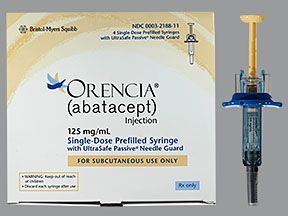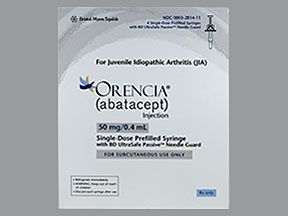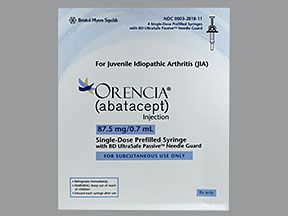Orencia (abatacept) is a brand-name prescription medication. The Food and Drug Administration (FDA) has approved it to treat the following conditions:
- psoriatic arthritis in adults
- rheumatoid arthritis in adults
- polyarticular juvenile idiopathic arthritis in children ages 2 years and older
It’s also approved to help prevent acute (sudden) graft-versus-host disease that can be caused by hematopoietic stem cell transplantation. For this use, Orencia can be given to adults and children ages 2 years and older. And it’s given with certain other drugs.
Orencia comes as a solution that’s given by subcutaneous injection or by IV infusion.
The active drug in Orencia is abatacept, which is a
For information about the dosage of Orencia, including its strengths and how to take the drug, keep reading. For a comprehensive look at Orencia, see this article.
This article describes typical dosages for Orencia provided by the drug’s manufacturer. When receiving Orencia, always follow the dosage prescribed by your doctor.
Keep reading to learn more about Orencia dosages, including the drug’s dosing frequency, IV dosing, and loading dose.
Orencia forms
Orencia comes as a solution in the following forms:
- single-dose prefilled syringe for subcutaneous injection
- single-dose prefilled ClickJect autoinjector for subcutaneous injection
- single-dose vial for IV infusion
Note: Your doctor or pharmacist may abbreviate subcutaneous as “sq” on your prescription.
Orencia strengths
The table below details different Orencia strengths for each form of the Orencia:
| Vial for IV infusion | Syringe for subcutaneous injection | ClickJect autoinjector for subcutaneous injection |
| 250 milligrams (mg) | 50 mg per 0.4 milliliters (50 mg/0.4 ml) | 125 mg/ml |
| 87.5 mg/0.7 ml | ||
| 125 mg/ml |
Typical dosages
The following information describes dosages that are commonly prescribed or recommended. However, be sure to take the dosage your doctor prescribes for you. Your doctor will determine the best dosage to fit your needs.
Dosage for psoriatic arthritis
For treating psoriatic arthritis (PsA), Orencia may be given as a subcutaneous injection, or as an IV infusion.
Subcutaneous injection dosage for PsA
For treating PsA by subcutaneous injection, the recommended Orencia dosage is 125 mg once per week.
IV infusion dosage for PsA
For treating PsA by IV infusion, you’ll first receive a loading dose of Orencia. A loading dose is a high dose given at the start of treatment to help the medication work faster.
The loading dose is given as three separate infusions at weeks 0, 2, and 4. After this, you’ll receive Orencia infusions once every 4 weeks.
Your doctor will determine your Orencia IV infusion dosage based on your body weight in kilograms (kg), as shown in the chart below. 1 kg is about 2.2 pounds (lb).
| Body weight | Dose | Number of vials needed |
| Less than 60 kg (less than about 132 lb) | 500 mg | 2 |
| 60 kg to 100 kg (about 132 lb to 220 lb) | 750 mg | 3 |
| More than 100 kg (more than about 220 lb) | 1000 mg | 4 |
Dosage for rheumatoid arthritis
For treating rheumatoid arthritis (RA), Orencia may be given as a subcutaneous injection or as an IV infusion.
Subcutaneous injection dosage for RA
For treating RA by subcutaneous injection, the typical Orencia dosage is 125 mg. The dosing frequency for RA is once per week.
Before your first dose, your doctor may give you a single loading dose of Orencia as an IV infusion. A loading dose is a high dose given at the start of treatment to help the medication work faster. Talk with your doctor about whether they’ll prescribe a loading dose for you.
Note: Your doctor or pharmacist may abbreviate subcutaneous as “SQ” on your prescription.
IV infusion dosage for RA
For treating RA by IV infusion, you’ll first receive a loading dose of Orencia.
The loading dose is given as three separate doses at weeks 0, 2, and 4. After that, your dosing frequency will be once every four weeks.
Your doctor will determine your Orencia IV infusion dosage based on your body weight in kg, as shown in the chart below. 1 kg is about 2.2 lb.
| Body weight | Dose | Number of vials needed |
| Less than 60 kg (less than about 132 lb) | 500 mg | 2 |
| 60 kg to 100 kg (about 132 lb to 220 lb) | 750 mg | 3 |
| More than 100 kg (more than about 220 lb) | 1000 mg | 4 |
Dosage for acute graft-versus-host disease prevention
To help prevent acute (sudden) graft-versus-host disease, Orencia is given as an IV infusion. The typical dosage is 10 mg per kg of body weight. The maximum dosage of Orencia for this use is 1,000 mg.
For example, if you weigh 65 kg (about 143 lb), you’d receive 650 mg of Orencia per infusion.
Orencia is infused on the day before hematopoietic stem cell transplantation and on days 5, 14, and 28 after the transplant. It’s given in combination with methotrexate (Trexall) and a type of drug called a calcineurin inhibitor. You might start taking these drugs before you begin the Orencia treatment, and your doctor might have you continue taking them after your transplant.
Children’s dosage
Below are the recommended dosages of Orencia for children.
Children’s dosage for polyarticular juvenile idiopathic arthritis
Orencia is approved to treat polyarticular juvenile idiopathic arthritis (pJIA) in children ages 2 years and older. For this condition, it may be prescribed alone or in combination with the medication methotrexate (Trexall). Your child might receive Orencia as a subcutaneous injection or as an IV infusion, depending on their age.
Subcutaneous injection dosage for pJIA
When given by subcutaneous injection in children ages 2 years and older, Orencia is given once per week. Your child’s dose will be determined based on their weight in kg, as shown in the table below.
| Child’s body weight | Weekly dose |
| 10 kg to less than 25 kg (about 10 lb to less than 55 lb) | 50 mg |
| 25 kg to less than 50 kg (about 55 lb to less than 110 lb) | 87.5 mg |
| 50 kg or more (about 110 lb or more) | 125 mg |
IV infusion dosage for pJIA
Orencia may be given as an IV infusion to treat pJIA in children ages 6 years and older. Children ages 2 years to fewer than 6 years old should receive Orencia by subcutaneous injection.
Your child’s dose will depend on their weight in kg, as follows:
- In children who weigh fewer than 75 kg (about 165 lb): Orencia is given in a dose of 10 mg per kg. For example, a child weighing 30 kg (about 66 lb) will receive a 300 mg infusion.
- In children weighing 75 kg (about 165 lb) or more: the adult dosing chart should be used, up to a maximum dose of 1,000 mg. For example, a child weighing 78 kg (about 178 lb) will receive a dose of 750 mg. See the adult dosing chart in the “IV infusion dosage for RA” section above.
Your child will receive Orencia infusions at weeks 0, 2, and 4. After this, your child will have an infusion every 4 weeks.
Children’s dosage for acute graft-versus-host disease
Orencia is approved to help prevent acute (sudden) graft-versus-host disease in children ages 2 years and older. For this use, the drug is given as an IV infusion.
Your child’s dosage will depend on their age, as follows:
- In children ages 6 years and older: 10 mg/kg (milligrams of drug per kilogram of body weight)
- In children ages 2 to less than 6 years old: 15 mg/kg for the first infusion, followed by 12 mg/kg for the next infusions.
For example, if your child is over age 6 and weighs 38 kg (about 143 lb), they’d receive 400 mg of Orencia per infusion.
Your child will have Orencia infusions on the day before their hematopoietic stem cell transplantation and on days 5, 14, and 28 after the transplant.
Your child’s doctor will prescribe Orencia in combination with methotrexate and a type of drug called a calcineurin inhibitor. Your child might start taking these drugs before beginning the Orencia treatment and might continue taking them after the transplant.
Long-term treatment
Orencia is meant to be a long-term treatment for arthritis. If you and your doctor determine that Orencia is safe and effective for you, you’ll likely receive it long term.
If you’re receiving Orencia to help prevent acute (sudden) graft-versus-host disease, your treatment might last for about a month.
The Orencia dosage your doctor prescribes will depend on several factors. These include:
- the type and severity of the condition you’re taking Orencia for
- the form of Orencia you’re prescribed
- your age
- your weight
Orencia may be given as either an IV infusion or as a subcutaneous injection. Be sure to follow instructions from your doctor or healthcare professional about how to take Orencia.
Orencia by IV infusion
If you’re receiving Orencia as an IV infusion, you’ll need to schedule infusion appointments at your doctor’s office, an infusion or healthcare clinic, or similar setting. A healthcare professional will insert a needle into your vein and connect it to a bag filled with liquid containing Orencia.
Orencia infusions usually last around 30 minutes if you’re taking the drug for arthritis. For prevention of acute (sudden) graft-versus-host disease, Orencia infusions last for about 60 minutes. During this time, the liquid containing Orencia slowly drips into your vein.
Your doctor or another healthcare professional may monitor you for a few minutes at the end of your infusion. This is to make sure you don’t have any serious side effects from the infusion.
Orencia by subcutaneous injection
Your doctor may prescribe Orencia as a subcutaneous injection if you’re using it for psoriatic arthritis, rheumatoid arthritis, or polyarticular juvenile idiopathic arthritis.
Your doctor or healthcare professional will give you your first injection of Orencia. Then they may show you how to give yourself your next injections at home.
Orencia injections may be given using either a prefilled syringe or a prefilled ClickJect autoinjector. You won’t have to measure out your Orencia dose with either form. Each syringe or autoinjector will contain the exact amount of Orencia that your doctor prescribes for each injection.
The Orencia website contains more information about self-injecting Orencia. You can also talk with your doctor or pharmacist if you have questions about giving yourself Orencia injections.
If you miss an appointment for an Orencia infusion or injection, contact your doctor or healthcare professional as soon as possible. They can help reschedule your appointment for as soon as they have availability. It’s very important to get your infusion as soon as possible, because symptoms of your condition may come back if you go too long without an Orencia dose.
If you give yourself Orencia injections at home and you miss a dose, try to give yourself the missed dose as soon as you remember. You should then call your doctor, as they can help set up a new dosing schedule for you. Do not give yourself more than one Orencia dose at once.
To help make sure that you don’t miss a dose, try using a medication reminder. This can include setting an alarm or using a timer. You could also download a reminder app on your phone.
It’s important that you do not give yourself more Orencia than your doctor prescribes. For some medications, taking more than the recommended amount may lead to side effects or overdose.
If you give yourself more than the recommended amount of Orencia
Call your doctor right away if you believe you’ve given yourself or received too much Orencia. Another option is to call the American Association of Poison Control Centers at 800-222-1222 or use its online tool. If you have severe symptoms, immediately call 911 or your local emergency number, or go to the nearest emergency room.
The dosages in this article are typical dosages provided by the drug’s manufacturer. If your doctor recommends Orencia for you, they will prescribe the dosage that’s right for you. Always follow the dosage that your doctor prescribes.
As with any drug, never change your dosage of Orencia without your doctor’s recommendation. If you have questions about the dosage that’s right for you, talk with your doctor.
Besides learning about dosage, you may want other information about Orencia. These additional articles might be helpful to you:
- More about Orencia. For information about other aspects of Orencia, see this article.
- Side effects. To learn about side effects of Orencia, see this article. You can also look at the Orencia prescribing information.
- Details on arthritis. For details about this condition, see our arthritis hub and list of rheumatology articles. To learn more about psoriatic arthritis, you can also see our list of psoriatic arthritis articles.
Disclaimer: Medical News Today has made every effort to make certain that all information is factually correct, comprehensive, and up to date. However, this article should not be used as a substitute for the knowledge and expertise of a licensed healthcare professional. You should always consult your doctor or another healthcare professional before taking any medication. The drug information contained herein is subject to change and is not intended to cover all possible uses, directions, precautions, warnings, drug interactions, allergic reactions, or adverse effects. The absence of warnings or other information for a given drug does not indicate that the drug or drug combination is safe, effective, or appropriate for all patients or all specific uses.



